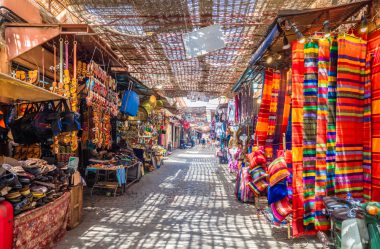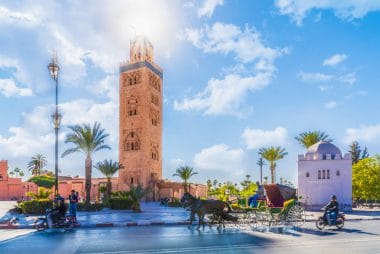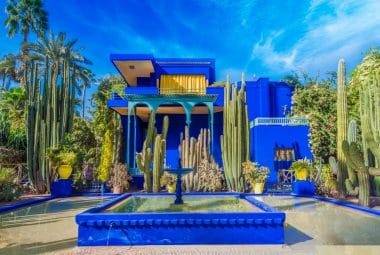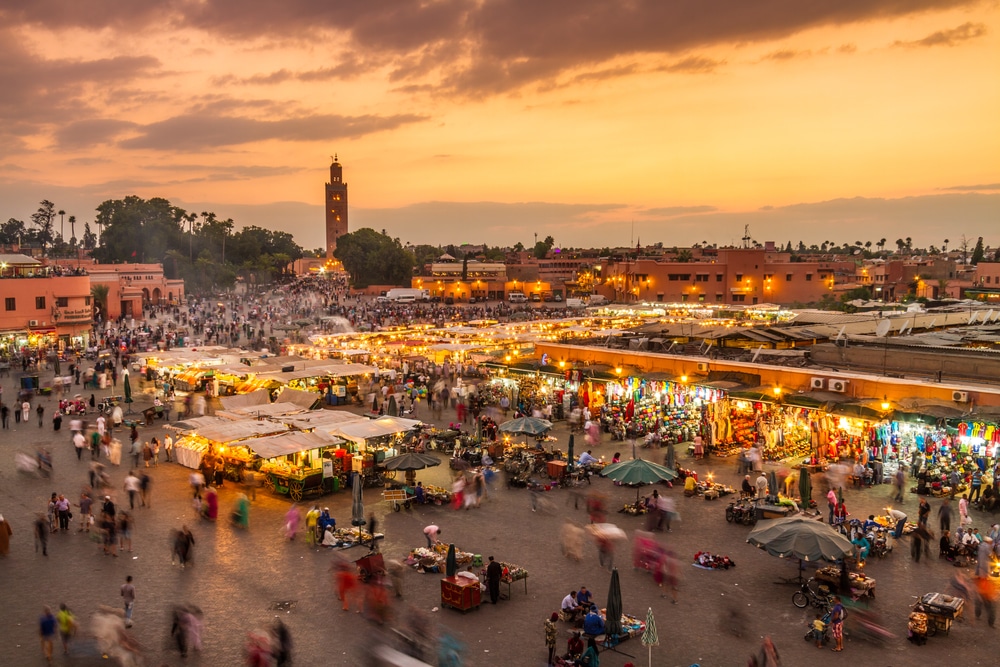Bright colors and patterns, Arab-French voices mix with oriental sounds and the unique scent of fresh spices and sweet fruits. Marrakech is a dream! Today we take you on a unique journey: discover the highlights of this beautiful city and plan your holiday in Morocco.
The cultural heritage of Marrakech

The Kingdom of Morocco is a North African state with a great influence of Berber culture. This is still visible in many of the country’s cultural assets. Berber jewellery made of silver, traditional ceramics, handmade slippers or Berber carpets made of wool are what captivate and delight travellers when visiting the city’s markets. The products are also popular souvenirs!
But the city has also had an eventful time: in 1912, the Sultan signed the Treaty of Fez. Morocco lost its independence to France for many years. French became the official language in Morocco. European settlers bought land, built houses and took on important functions in business enterprises, public administration, banking and politics at incredibly low prices. In the years that followed, there were repeated protests and uprisings. As a result, the sultan was exiled together with his family. But there was no end to the uprisings among the population. France came under increasing criticism. The pressure from outside became stronger. In 1956, France granted independence to the country. Sultan Mohammed V became the new head of state of Morocco.
Well-known sights

Marrakech has a lot to offer! Countless sights invite visitors to explore the city on their own. The medina of Marrakech is crisscrossed by endless alleys. All end at Jemaa al Fna – the main square of the old town. Early in the morning, countless traders move into their market stalls here, which are lined up close to each other. Here you will find henna painters, next to snake charmers or shoe shiners. But there is always something going on here in the evening as well. Then it smells of barbecue and countless spices that come from the many food stalls.
UNESCO has rightly named the square a World Heritage Site. In the north of Marrakech lies the Jardin Majorelle. It is considered the most beautiful garden in the city. You can quickly reach your destination by taxi and enjoy the unique sight at your leisure. A little paradise! You can also visit the Bahia Palace. The ornate complex from the 19th century is worth a visit. Inside, there are 160 rooms, countless courtyards and a 3-hectare garden – incredible!
A visit to the Koutoubia Mosque is similarly impressive. It was built in the 12th century and includes a wonderful garden with a fountain. At the Marrakech Museum, you can learn about the city’s history and visit an exhibition of fine arts. The Saadian tombs house the Sultan’s Mausoleum with colorful mosaics and expensive marble. It’s worth a visit!
Culinary delights – Moroccan food culture
Marrakech’s cuisine is one of the most diverse in the world. Experience a completely different food culture and discover traditional specialties with regional origins. Morocco’s most famous national dish is certainly the tagine. In a clay stew vessel, typical dishes are prepared. The tagines are filled with meats such as lamb, chicken or pigeon. In addition, there are various spices that are typical for Morocco. Garlic, paprika and saffron are just three of the types of spices found here. The meat is slowly cooked in the tagine and then served with rice. But not only rice is a popular side dish. Couscous is also a must on any Moroccan dinner table. Couscous is served in countless variations. Be sure to try it sweet, too.
With raisins, dates, cinnamon and plums, couscous is a great taste experience. A third component that is never missing is fresh vegetables and fruits. Popular vegetables grown locally are: peppers, onions, zucchini, tomatoes. Anyone who has already tested Moroccan cuisine knows that Moroccans like to serve fruit with main courses. In combination with chicken or turkey, the mixture of sweet and savory is a tasty alternative to vegetables. Lovers of lamb should not miss to taste Mechoui. It is a tasty oven dish traditionally served with Arabic bread. Of course, a holiday in Marrakech should never end without enjoying a sweet dessert: try b’stilla – crispy sheets of dough with almonds, cinnamon and sugar. If you like it fruity, order a fresh orange salad. This is served with dates and fresh almonds. If it may not be sweet enough for you, try white nougat!
Excursions around Marrakech

There are a variety of excursions to visit Marrakech. How about day trips outside of Marrakech? This way you will get to know the country better and collect unforgettable impressions. A great idea is the trip to Essaouira. The small port city is located on the Atlantic coast and has a lot to offer. Take a guided tour of the city and visit the Berber women. They produce argan oil according to old tradition.
If you love adventure, you should book a three-day desert safari. You will spend the night in the Bedouin camp of Erg Chebbi and experience the Moroccan Sahara up close – a unique experience. On small roads you explore the Atlas Mountains and reach the Dades Gorge. Another highlight of the tour is certainly the Moroccan dinner under a clear starry sky. The tour to the Ouzoud Waterfalls is also very popular: bathe at the foot of the waterfall, in the El-Abid River and visit traditional Berber villages.
Holidays in Marrakech: Important information
Important telephone numbers
- Police: 19
- Fire brigade: 15
- Ambulance: 15
- General emergency: 112
- German Embassy in Rabat: +212 537 21 54 60
Supermarkets
- Carrefour: Avenue de la Menara, Marrakech
- Marjane: Route de Casablanca, Marrakech
- Acima: Avenue Mohamed V, Marrakech
- Aswak Assalam: Route de Targa, Marrakech
Doctors in the most important places
- Marrakech:
- Dr. Abdelaziz Rachidi: Ibn Tofail Clinic, Rue Yougoslavie, +212 524 448 648
- Dr. Mohamed Bouskine: Avenue Mohamed V, +212 524 446 688
- Dr. Leila Benomar: Avenue Hassan II, +212 524 433 033
Important words with translation
- Hello – Salam
- Thank you – Shukran
- Please – Afak
- Yes – Na’am
- No – La
- Sorry – Afwan
- Where is…? – Ayna…?
- How much does it cost…? – Bikam…?
- Emergency – Tariq al-ahya’
- Doctor – Tabib
- Hospital – Mustashfa
Holidays
- New Year’s Day: January 1
- Independence Day: January 11
- Labour Day: 1 May
- Throne Festival: July 30
- King’s birthday: August 21
- Green March: November 6
- Independence Day: November 18
- Islamic holidays: variable (depending on the Islamic calendar), e.g. Eid al-Fitr, Eid al-Adha, Mouloud (birthday of the Prophet)
Opening hours
- Shops: Usually Monday to Saturday from 9:00 a.m. to 9:00 p.m. Many shops close during midday prayers.
- Supermarkets: Usually daily from 9:00 a.m. to 10:00 p.m.
- Restaurants: Lunch from 12:00 to 15:00, dinner from 19:00 to 23:00.
- Banks: Monday to Friday from 8:30 a.m. to 4:00 p.m.
Airport
- Marrakech Menara Airport (RAK): About 5 km southwest of Marrakech city center
NUDISM
- Not common: There are no official nudist beaches or facilities in Marrakech or Morocco. Nudism is not practiced and could be considered offensive.
Post / Stamps
- Post Offices: In all major districts of Marrakech. Main Post Office on Avenue Mohamed V. Opening hours: Monday to Friday from 8:00 a.m. to 4:30 p.m.
- Stamps: Available at post offices and kiosks.
- Costs for letters and postcards to Germany: Standard letter up to 20g: approx. 10 MAD; Postcard: approx. 7 MAD
Safety
- Crime: Marrakech is relatively safe, but as in any big city, you should be attentive. Beware of pickpockets in crowds and markets.
- Emergency number: 19 (police), 15 (fire and rescue service)
Current
- Voltage: 220 Volts
- Sockets: Type C and E. Adapters for European plugs are usually not required.
Tip
- Restaurants: 10% of the invoice amount
- Taxis: Round up the amount
- Hotels: 1-2 EUR per day for cleaning staff
Customs
- Allowances within the EU: Personal belongings are duty-free.
- Alcohol: Maximum 1 liter of spirits or 2 liters of wine.
- Tobacco: 200 cigarettes or 50 cigars or 250g of tobacco.
- Other items: Value up to MAD 2,000 duty free.


